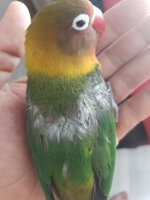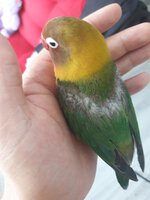Zuma Dandy
Moving in
- Joined
- 5/15/21
- Messages
- 7
Hello dear lovebird lovers.
My guy Rio has a problem. But we don't understand what it this, what caused this or what to do. As seen in the pictures, there is a molted/sparsed/feather-lost area above his wings/shoulders. It started around 6-7 months ago. At first, we thought it was seasonal molting. Then it slowly getting covered up bigger area. And no avian vet in my city.
So, what is that exactly? What to do?
For dear friends who interested, let me give you more details;
We adopted Rio from a family a year ago. He was 6 month old. So now around 1.5 years old. He lives alone. He has a mountain view cage. Minimum twice a day, he flies in the room cage-free, hang out with me and my wife, playful and all. Same and quality complete bird food since day one. Occasionally, vitamin support to his water. He used to close his eyes and singing as the vet called "happy sleep". But he doesn't do that anymore. As in the same time as his feathers start to be like that, he also started to squawking louder and more often. we had to start to cover his cage up for him to be silent during my wife's online lessons. There is nothing else different about his behave and act. Oh, and he never sleeps on the roost/branch at night, he always sleep at the same bottom corner of the cage, since day one.
I'll be grateful if anyone help me about it.
My guy Rio has a problem. But we don't understand what it this, what caused this or what to do. As seen in the pictures, there is a molted/sparsed/feather-lost area above his wings/shoulders. It started around 6-7 months ago. At first, we thought it was seasonal molting. Then it slowly getting covered up bigger area. And no avian vet in my city.
So, what is that exactly? What to do?
For dear friends who interested, let me give you more details;
We adopted Rio from a family a year ago. He was 6 month old. So now around 1.5 years old. He lives alone. He has a mountain view cage. Minimum twice a day, he flies in the room cage-free, hang out with me and my wife, playful and all. Same and quality complete bird food since day one. Occasionally, vitamin support to his water. He used to close his eyes and singing as the vet called "happy sleep". But he doesn't do that anymore. As in the same time as his feathers start to be like that, he also started to squawking louder and more often. we had to start to cover his cage up for him to be silent during my wife's online lessons. There is nothing else different about his behave and act. Oh, and he never sleeps on the roost/branch at night, he always sleep at the same bottom corner of the cage, since day one.
I'll be grateful if anyone help me about it.
Attachments
-
86.6 KB Views: 14
-
87.9 KB Views: 31









